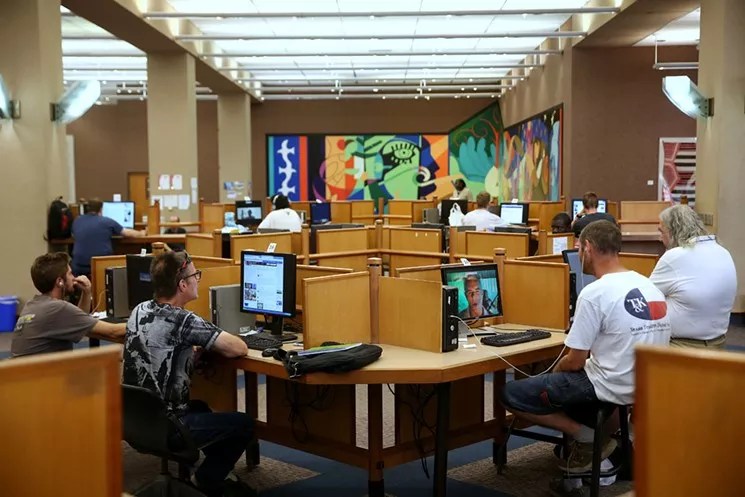
Dylan Hollingsworth

Audio By Carbonatix
Dallas Public Library leaders always knew they’d have to get “creative” to make the library system outlined in a massive, 20-year facilities plan approved by the Dallas City Council last year a reality. Eighteen months later, budget constraints have left the North Star plan looking more like a pie-in-the-sky wishlist.
The plan called for a complete overhaul of downtown’s J. Erik Jonsson Central Library, as well as the expansion or replacement of 11 other library branches around the city. It certainly doesn’t recommend closing any branches, although in the plan’s nearly 150 pages, only three paragraphs discuss the “funding strategies” needed to help realize the upgrades recommended for Dallas’ libraries. (Those strategies amount to little more than a, “Please, sir, I want some more bond money.”)
City Hall is in a fundamentally different place financially than it was last April, when the plan was approved. Today is the first day of the new fiscal year, which means it’s the first day Marilla Street is working with the biggest budget it’s ever seen, even though many departments are squeezed tighter than ever before, including the library system. Our credit rating outlook has been downgraded, and two-thirds of the city’s funding this year will be put towards the police and fire departments, leaving other city services on the chopping block.
When news happens, Dallas Observer is there —
Your support strengthens our coverage.
We’re aiming to raise $30,000 by December 31, so we can continue covering what matters most to you. If the Dallas Observer matters to you, please take action and contribute today, so when news happens, our reporters can be there.
The Skillman Southwestern Branch Library closed over the weekend after the city council debated a handful of amendments that would have saved or shuttered it. Library leaders have already been informed that, in fiscal year 2027, approximately $2.6 million in additional savings needs to be found, meaning more branches are likely to close.
“As we started to look at the budget and the amounts of money that we need to save in FY27, there are only two ways to save that amount of money. That’s either to reduce hours and days, like we have done eight times in the past 15 years, or we could take another approach,” said Manya Shorr, director of the Dallas Public Library. “Unfortunately, the facilities plan just wasn’t as helpful for that development as I would have hoped it would be.”
“It was very clear very quickly, we either need a doubled budget, or we need fewer locations,” she added.
The first discussions about FY27’s budget are expected to begin in December, leaving library leaders with only a few months to determine which additional branches should close. The criteria for that decision have yet to be established, Shorr said, and community input will be solicited. However, she hopes to engage in a more “robust” conversation than “we don’t want our library to close.”
“My desire is not to close libraries, no library director wants to do that,” she said. “At the end of the day, what we’re looking for here is stability with some strategy and intention.”
Shorr, who was announced for the director role in June after running the Fort Worth Public Library system, said she was “shocked” to start in her role and realize the budget pressures that DPL has been “quietly” experiencing for years.
The library budget peaked at $36 million in the 2007-2008 budget; adjusted for inflation, that would be around $50 million today, and the system comprised 26 facilities. This year, DPL’s 30 facilities were given $43 million in the budget. In comparison, Austin allocates $70 million annually to its library system, and San Antonio’s library budget is nearly $60 million.
Shorr believes the library system’s path forward is moving towards a “regional model.” In Tuesday evening’s municipal library board meeting, she explained that in the coming months, library leaders will identify four library branches around the city that will transition to “regionals”: seven-day-a-week facilities with extended hours. The Vickery Park Branch Library already follows this model, so DPL will sponsor a total of five regional branches.
“If we double down on these regional libraries, we’ll be open around the city at key locations when our community needs us, which is something that we’re not able to achieve right now,” Shorr said.
According to Shorr, the 20-year facilities plan, which was put together over the course of a year by the consulting firm Group 4 Architecture, was primarily paid for by the Friends of the Dallas Public Library, not taxpayers. She hopes the document doesn’t end up totally “trashed,” even if the guidance outlined isn’t exactly the path the library system now seems to be on.
The plan was useful, she added, during last year’s city bond conversation. The 2024 bond earmarked $43.5 million for the Park Forest and North Oak Cliff Branch Libraries, and in Tuesday’s meeting, Shorr said the City Council’s Quality of Life committee will begin the process of finalizing those bond dollar plans later this month. The document also offers a comprehensive overview of the sorts of facility maintenance that will be needed in the coming decades — that type of upkeep has historically fallen into the city’s blind spot.
“It feels a bit incomplete rather than something we won’t use altogether,” Shorr said. “I think there was a missed opportunity to talk about alternative service models, to really look at the landscape of the city, and to talk about where there may be gaps.”